Story – Christopher Hector
It was going to be the great breakthrough in horse breeding – clones. Great stallions – like Quidam de Revel – could live on forever, the great geldings, like Rusty, Gem Twist and ET could become great stallions.
Welcome to the brave new world, or was it?
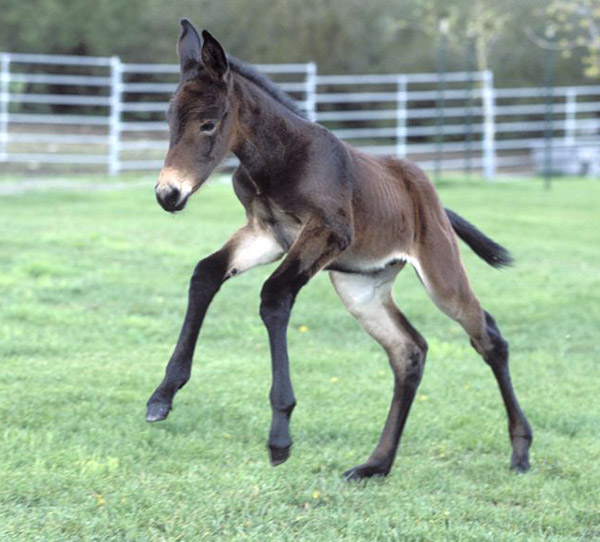
The first equine clone, a male mule named Idaho Gem, was born in Idaho, America on 4 May 2003. The birth was described as “a milestone in equine genetics and breeding.”
The first cloned horse foal to be born was Prometea, a Haflinger who arrived on 28 May 2003 in Italy. On 24 February 2005, the same team of scientists were responsible for the birth of Pieraz-Cryozootech-Stallion, a clone of the international endurance champion gelding, Pieraz.
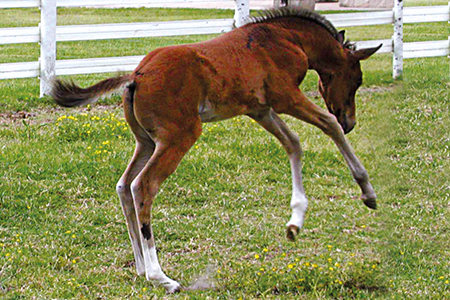
Quidam de Revel II Z
The sporthorse world, lead by Frenchman, Cryozootech head, Eric Palmer, was quickly into action. The clone of Quidam de Revel – Quidam de Revel II Z – was born in 2005. Five foals by the Quidam clone were recorded in 2013, at the time he was standing at Joris de Barbander’s Stal de Muze, arguably the most successful jumping breeding operation in the world, not surprisingly they were out of some very fancy mares. Six years later, twenty four offspring are recorded on the hippomundo database, only one seems to have a performance result, the 2013 foal, Nesquick de la Liniere (out of a Tinka’s Boy mare) has competed at 1.20 level. The Quidam clone is no longer listed on the stallion roster at Stal de Muze.
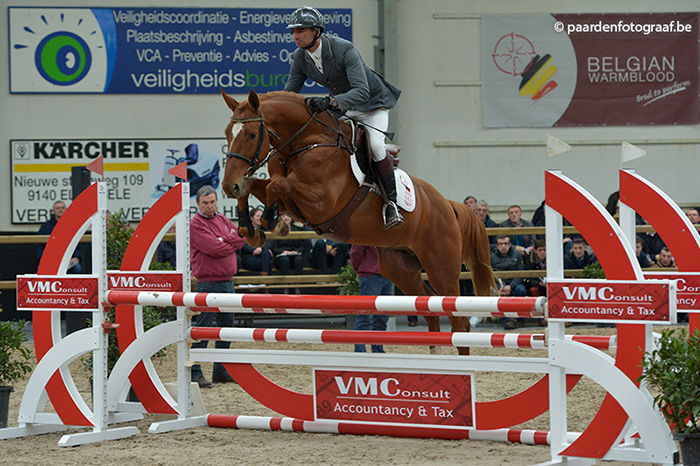
Nesquick de la Liniere
Back in 2016, I caught up with Joris and found that he was not so enthusiastic about clones:

“I don’t have problems, but I have found we really don’t need that – sometimes there are a few exceptions, like I use a lot the clone of Gem Twist, he was a gelding and a Thoroughbred. I have the clone of Quidam de Revel at my home, we use him a little bit, but I think this is ridiculous when you have a stallion that bred already three thousand foals, you don’t have to clone him and try and write the same story again, that’s worthless. You have to give chances to other bloodlines, young stallions, not try and do all the time the same things. What Léon Melchior is doing, cloning his good stallions, I don’t think that is a good idea. It exists now, and there are a few good clones so you can use them, but without the clones, breeding is also possible, I think.”
Three years later, Joris was not entirely sure where the Quidam clone was…
“He was at my place, but now he is in Poland, I think,” Joris told me. “He was three or four years at my place.”
And you decided he was not a success?
“No. I stood him because he was owned by the owner of Quidam at that time, so I did it for him. There are already 3000 foals of Quidam so another fifty by the clone would not make any difference, so I sent him back, and the owner sent him to Poland. His breeding was okay, it was the same as Quidam.”
When I look at the hippomundo data-base, I can find only one horse by the clone who has competed, and that was at 1.20 level…
“But the oldest are only five or six.”
That one was born in 2013…
“So six year olds, they are not going to be jumping 1.50 when they are six, do you find more six year olds by Quidam himself who were jumping better? The foals of the clone were the same horses as Quidam. The semen was the same as Quidam’s, I had a lot of foals by Quidam, and the ones by the clone, they were similar.”
With the Gem Twist clone, does the horse stand at your place?
“The clone of Gem Twist stays in France. The first foals I made from frozen semen, and then I used fresh semen and now again frozen semen. The foals are good, I use him a lot, and the first foals are now four years old. I have about ten foals and they are quite good but with this, you cannot compare with the original.”
“I am not such a fan for clones, it depends which horses you clone. If you clone Quidam, it’s stupid because he has had all the chances you can imagine for a stallion, so to make a clone of him, it makes no sense. But if you clone a gelding, or a stallion that missed his breeding career, it can be a nice thing in breeding. But is it really necessary? No. We can breed horses in a completely normal way. If you look at Thoroughbreds, they don’t use any artificial way of breeding, and they have a good breeding program. Do we really need these clones? I don’t think so, but if people want to make clones, why not – everybody gets what they want. We don’t need them, no, but I use them, yes, because they were there. I’ve never cloned a horse myself.”
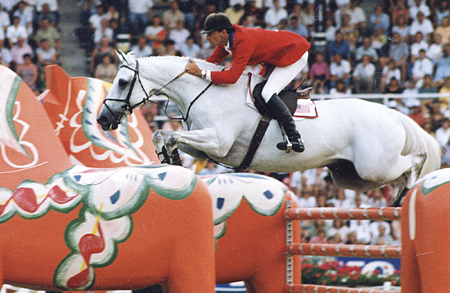
The great Gem Twist at the first WEG in 1990 with Greg Best
In the United States, the progeny of the Gem Twist clone, Gemini, are starting to make their mark. Laura Chapot, daughter of the breeder of Gem Twist, the late Frank Chapot, rode two in the Seven Year old championship at Florida’s recent Winter Equestrian Festival, finishing first on the gelding, Pursuit of Happiness (Cliton) and fifth on the mare, Timeless (Surrealist van’t Paradijs).
“The gelding has a very Thoroughbred-like feel,” Laura told Sara Cavanagh of The Horse of Deleware Valley. “He’s not fully matured yet, but he’s very careful. Both seven year olds are very green, but they learned really quickly, they’re very smart horses.”
“They’re very different,” said Chapot, who rode Gem Twist the winter that she was Rookie AGA Rider of the Year. “He’s super careful. She reminds me more of Gem Twist with the way she jumps. When she’s figured something out, she’s very bold. We went very slowly with Gem Twist, and we’re doing the same thing with these two.”
Quidam was not the only jumping great to be cloned, Hugo Simon’s gelding ET produced ET Cryozootech, and on Eric Palmer’s twitter account there is footage of a nice chestnut stallion, Et Cetera Z, competing in the four year old stallion championship in Fontainebleau in 2015. According to Mr Palmer, the young stallion’s round ‘is the proof of the concept of Cryozootech.’
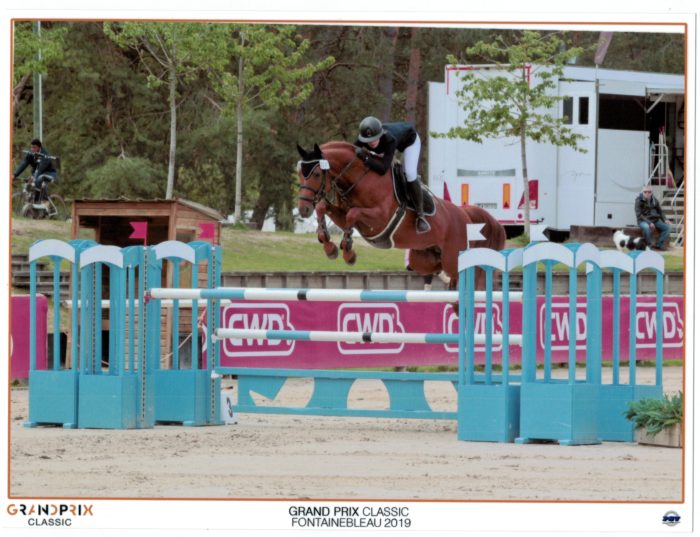
Et Cetera Z and Helene Palmer
The horse is by the ET clone out of a Selle Français mare by Jabad. The now eight year old stallion is competing with Eric Palmer’s daughter, Helene.
The most enthusiastic cloner, was the late Léon Melchior, and there are three cloned stallions on Zangersheide’s current stallion roster: Otterango Alpha Z, Air Jordan Alpha Z and Chellano Alpha Z.
Otterongo Alpha Z (born July 2014) is the clone of Ludo Philippaerts’ star gelding, Otterango (Darco / Hedjaz), individual 4th at the Sydney Games, winner of the Zurich, Monaco and Geneva Grand Prix.
The Otterongo clone has three competition results in 2019, including a 51st in the Pavo class for 5 year old stallions, and one win, at 1.15 level. No competition progeny are recorded.
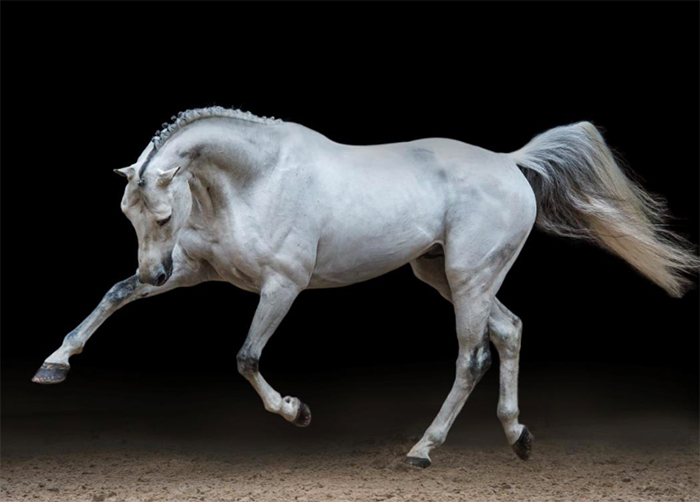
Chellano Alpha Z
Perhaps the most successful cloned stallion so far is Chellano Alpha Z, born in July 2008. Chellano (Contender / Cor de la Bryère / Captiol) himself had a moderate competition career, three international results, a 3rd in a 1.45 GP, and 3rd and 4th in the 7 and 6 year old championships at Lanaken. He was more successful as a sire, producing 29 progeny who have jumped 1.60, far and away the most successful of these has been HH Carlos (Voltaire) who in 2016 ranked 9th in the world, taking Chellano into 30th place on the rankings.
Chellano Alpha Z has two international placings, at the 2013 World Champs in Lanaken he was 219th and 165th in the five year old championship classes.
Chellano Alpha Z’s first crop appeared in 2013, currently there are 94 progeny are listed on the hippomundo database, jumping up to 1.45 level.
Air Jordan (Argentinus / Matador) was a star, placing 2nd at the World Cup final in Las Vegas in 2017. His clone, born 01/04/2009, has one international result, 13th in the five year old championship at Lanaken in 2014 with Christian Ahlmann. The clone is the sire of 105 progeny on the database, the most successful of which is Union de Flandre (Souviens Toi III, born 2008), her most recent results were 14th / 34th / 44th at 1.20 level at Kronenberg CSI 1*, in August 2018.
Not surprisingly Zangersheide cloned their star mare, Ratina Z (Ramiro / Almé). An article in Z Magazine in June 2015, outlined the program.
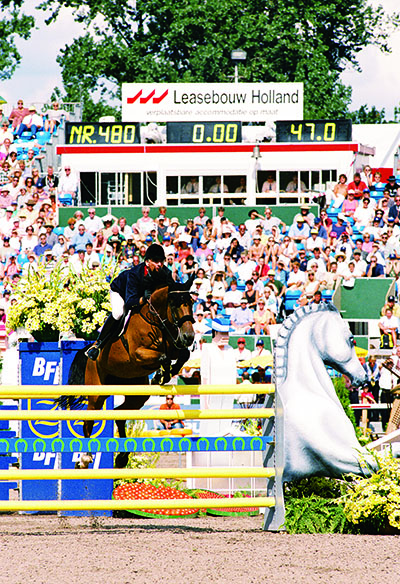
Ratina Z
Leon Melchior had three mares cloned in 2008. The following year three healthy foals were born, Ratina Alpha Z, Ratina Beta Z and Ratina Gamma Z. Ratina Beta Z died as a 2-yr-old of an accident in the field. The other two have been used as broodmares at Zangersheide.
Ratina Alpha Z was bred to Taloubet Z. The result was Taltina Z.
According to Z Magazine, “Taltina Z will be inseminated this year (2015)with the sperm of our promising Solid Gold Z (Stakkato Gold). But the mare will not carry the foal herself, Taltina Z will be saddle-broken this winter and gently guided towards the sport. One year after Taltina Z, Ratina Alpha Z produced the colt Aristoteles Z. His sire is the power-pack Aktion Pur Z. Together with his contemporaries Aristoteles Z is still enjoying his rearing phase, but his first free jumping performance makes us dream of a page in next year’s stallion catalogue with the title ‘Aristoteles Z’. This year Ratina Alpha Z will produce a foal by Solid Gold Z, a foal she is carrying and will rear herself. Just like Ratina Z did at the time with her firstlings.”
Seemingly Aristoteles Z did not make the cut, since he does not appear on the current Zangersheide stallion roster. Taltina herself competed last year, with her best result a 6th in a 1.20 class at Zangersheide.
Back to the Z story: “Ratina Gamma Z was served as a 2-yr-old by Clarissimo Z, two embryos were flushed and two foals were born. A colt and a filly. The colt, Claritino Z, stayed at Zangersheide and received his license for breeding earlier this year and is now available to the breeders. (As of 2019, he is not listed on Zangersheide list) The filly is called Call Me de Muze Z and is serving at the stud farm from Joris De Brabander. In order not to lose her genes in Zangersheide, either, a filly by Levisto Z was born at Zangersheide this year after embryo transplantation. The generations begin to follow each other more quickly now, because when this foal is born, Ratina Gamma Z is already a grand-dam as a 6-yr-old.”
“In 2013 Ratina Gamma Z had 3 foals. The stout Liber Z is a son of Levisto Z and is the spitting image of his sire, Caesar Z is a very handsome son of Chacco Blue and the third is a filly by Zandor Z called Zarina Z, who is the mirror reflection of her dam, Ratina Z.”
“The last Ratina Z offspring for the time being are these from 2014. They are yearlings with the single task for the next few years of grazing and playing, with no pressures at all. One of them did, however, already make headlines last year. Air Ratina Z was the first foal born from two cloned showjumping horses; her sire is Air Jordan Alpha Z. Not yet in the limelight are her two half-brothers from the same year; Action Man Z, a son of Aktion Pur Z, and Captain Sparrow Z, a son of the much promising Comilfo Plus Z.”
“A fourth clone, Ratina Delta Z, was born on 17 February 2015 in Texas and arrived at Zangersheide three months ago. It is sensational to see her similarity to the original Ratina Z and she is also giving us high hopes for the future!”
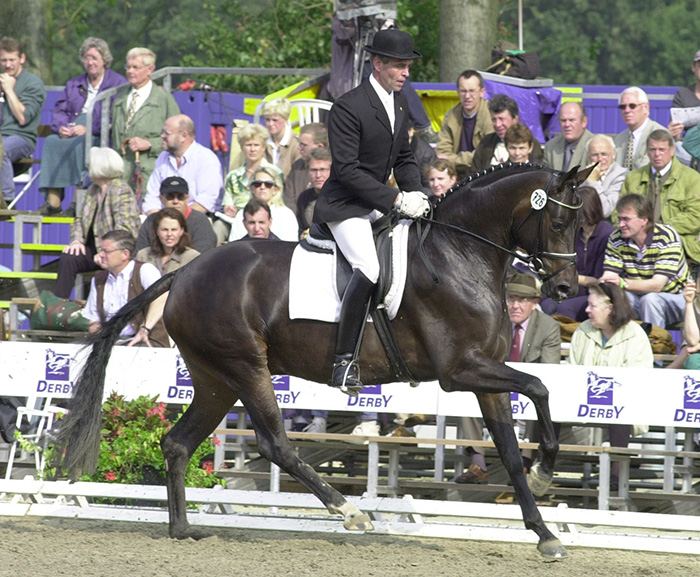
Poetin
Poetin’s career was shorter than Ratina’s, though just as spectacular, in the dressage ring. The mare (by Sandro Hit out of a Brentano mare) was a mega-star. She came to a sorry and legally convoluted end at Xavier Marie’s Haras de Hus, but not before two clones were produced in 2007. Clone 1 – Poetin Z 1- has produced four foals, two by Don Juan de Hus, one each by Rock Forever and Fürstinball. Dorian Grey de Hus by Don Juan, placed 5th in the Five Year old finals at the World Young Horse champs in 2018.
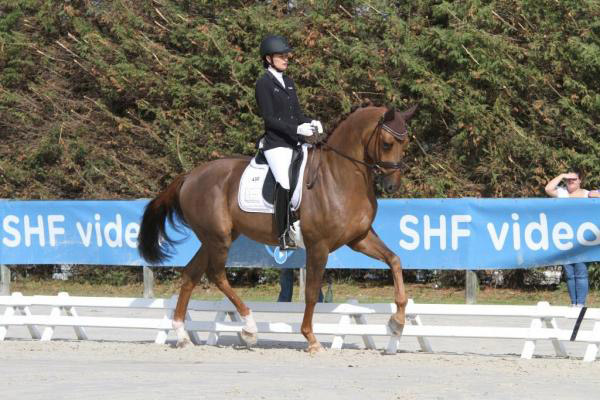
Dorian Grey de Hus
Poetin Z II has been more prolific, producing eight foals, two by Fidertanz, one each by Dancier, Totilas, Danone, Rock Forever, Negro and Don Juan de Hus.
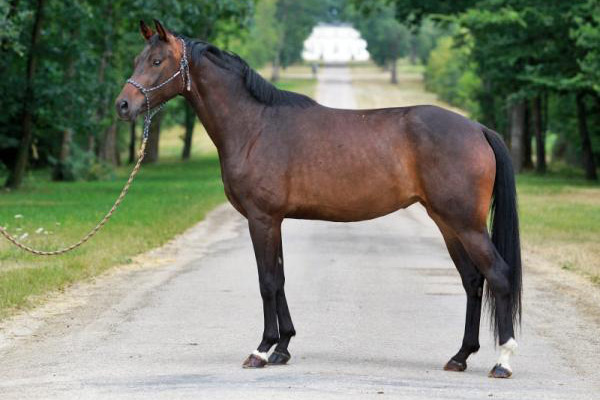
Poetin Z II
Cryozootech also proudly unvelied two yearling clones of Ulla Salzgeber’s Rusty in June 2013 – one in France, one in the US. Now this seems to me a clear example of muddle headed thinking, you don’t breed to freaks, and there is no doubt that Rusty was a freak, despite the fact that his sire, Rebus topped the WBFSH dressage sires rankings in 2000/2001, this was due to a crazy calculation formula that so weighted championship performances, that stallions, could, and were, ranked highly on the basis of just one offspring. Rusty was the only horse Rebus produced – the ultimate one hit wonder – not, one would have thought, the best bet to become a stallion. Way better to clone Ulla.
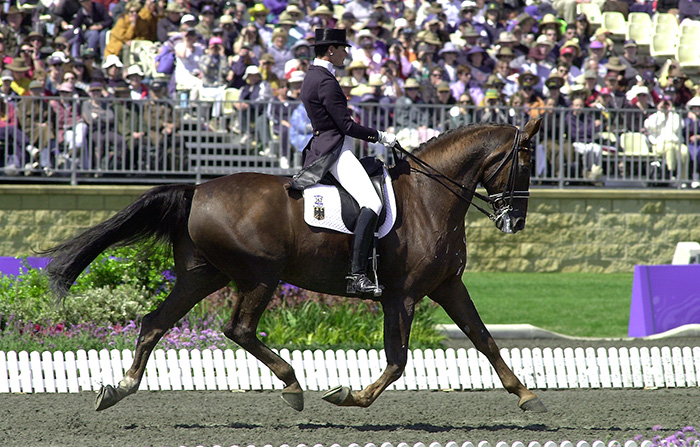
Rusty – better to clone Ulla…
There is movement on the eventing scene also, with a six year old stallion son of William Fox-Pitt’s Burghley winner, Tamarillo. Is this another attempt to breed to a freak?
the story continues below the ad…
I was lucky enough to catch up with Eric Palmer for his assessment of the current situation…
When did you decide to clone horses? What was your inspiration?
“After introducing A.I. to increase stallion productivity, embryo transfer to increase the production of high value mares, it seemed interesting to allow reproduction from champion horses who had been gelded and were excluded from the genetic progress. This is the basis for cloning Pieraz, E.T., Calvaro 5, Gem Twist, Rusty.”
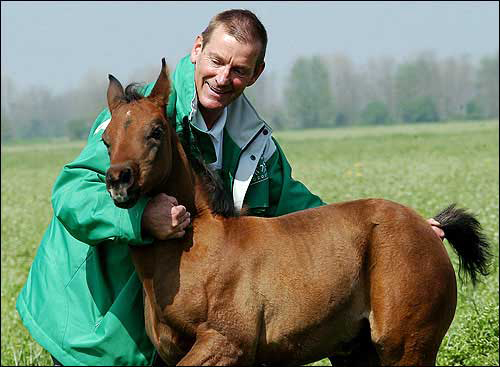
Eric Palmer with the clone of the Endurance star, Pieraz
“However the market had another point of view: owners of stallions ordered clones of their stallions: Quidam de Revel, Levisto Z, Chellano Z, Jazz, Zandor Z. Other owners of mares wanted to duplicate them, mostly for reproduction purposes: Ratina Z, Poetin, Famm.”
“A few wanted to duplicate their performer. In Argentina the cloning for performance was most developed by the Polorider Cambiasso.”
Which would you consider your most successful stallion clone?
“Commercially, Gemini, clone of Gem twist has had many mares. From their production I am proud of Pieraz who produces good endurance horses and specially of E.T. who in his first generation has one in the highest competitions (Eliot Brimbelles Z) and one that I produced (Et cetera Z) who is starting in international with my daughter!”
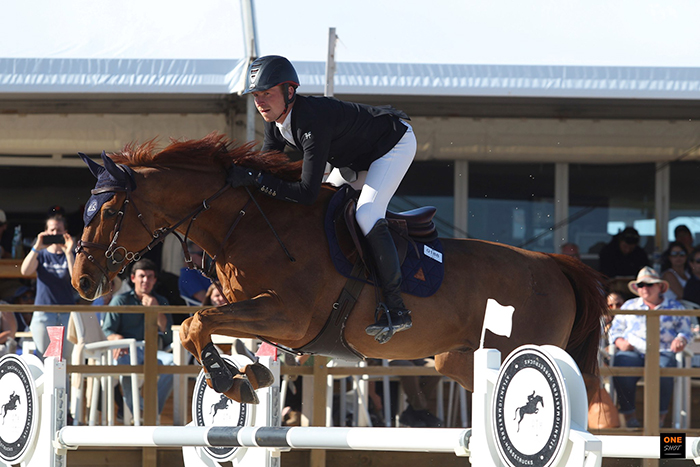
Eliot Bribelles Z is out of a Diamant de Semilly mare, and placed in the 1.45 / 1.50 classes at this year’s Shanghai 5 star, ridden by Frenchman, Titouan Schumacher.
Which would you consider your most successful mare clone?
“Ratina had three clones and there are many offspring.”
What has happened with the two Rusty clones? The people in Texas who had one tell me they think it is in France with you?
“There were two clones of Rusty; I wanted to leave one in the States and one in Europe. The one in the States got difficult to handle as a stallion in the stable, so that it was castrated and I brought it home to Europe. Presently they are both of them in my stables and I ride both of them (one stallion and one castrated) in low level dressage competition. No mare has been inseminated yet.”
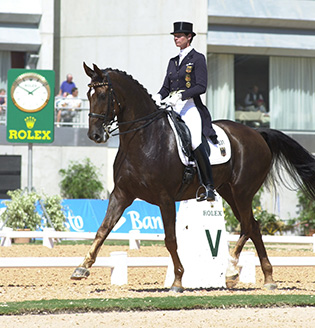
Are you still cloning horses?
“No, I still try to promote the stallions issued from cloning geldings and I own several horses issued from E.T. and Calvaro clones.”
It has been suggested that the most important developments from your cloning program was not the clones themselves but the development and/or improvement of techniques like iCSi or In-Vitro fertilization – do you agree?
“These are parallel developments. Although I produced the only two IVF foals, it is still very inefficient whereas iCSi has developed a lot with one company (Avantea) leader in Europe, several labs in the USA and in South America.”
The one area in which cloning would seem to have been an enormous success is in the area of polo ponies (come to think of it, polo ponies look a bit like clones already…) In December 2016, the world’s best polo player, Adolfo Cambiaso rode six horses in the team that took out a prestigious championship, and all six were clones of his famous mare, Cuartetera.
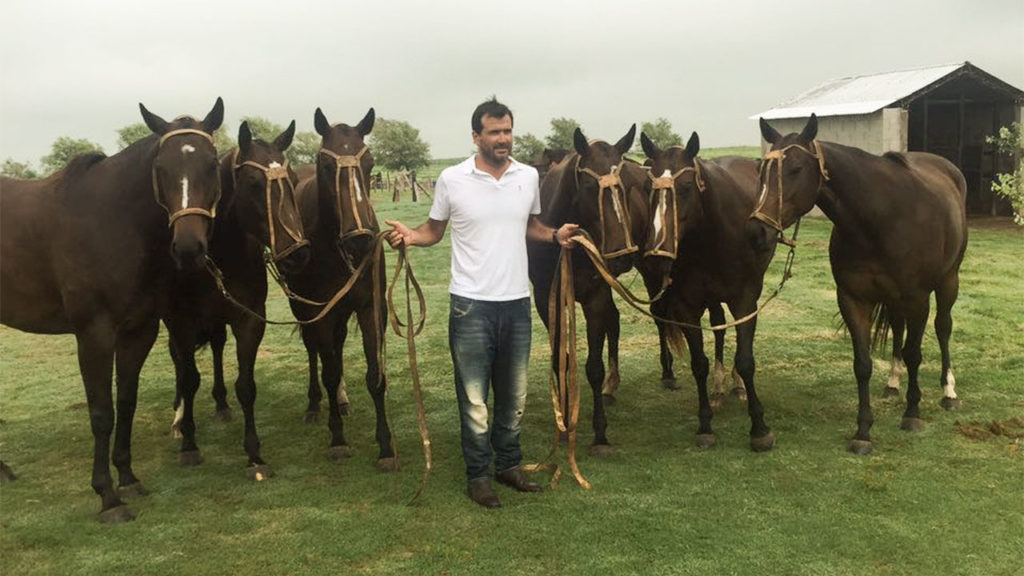



Precisely. The title of your article made me wonder. As I am Argentine and our cloned polo ponies are doing very well. Glad you gave them recognition credit at the end.
Good article.
thank you
very interesting
There will need to be greater numbers of clones on the ground to get a decent statistical sample and f how ‘good’ clones are. The best example of this is the very last part of the story- the polo ponies and should have been looked at more closely. All ridden by the same person in the same sport at the same time. This is the best statistically useful example if the validity of clones. There is too much variability in the other examples. The Gem Twist clones are the next best examples…
cloning in other species has been very successful.